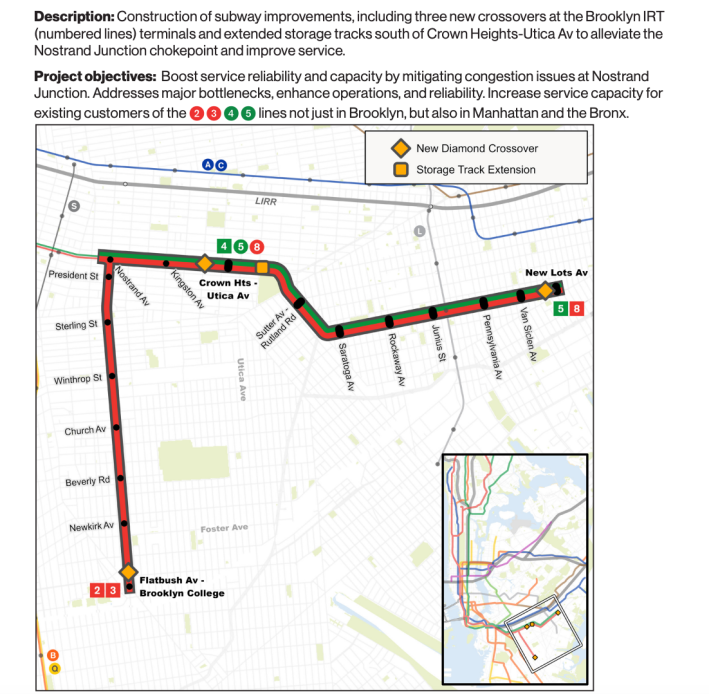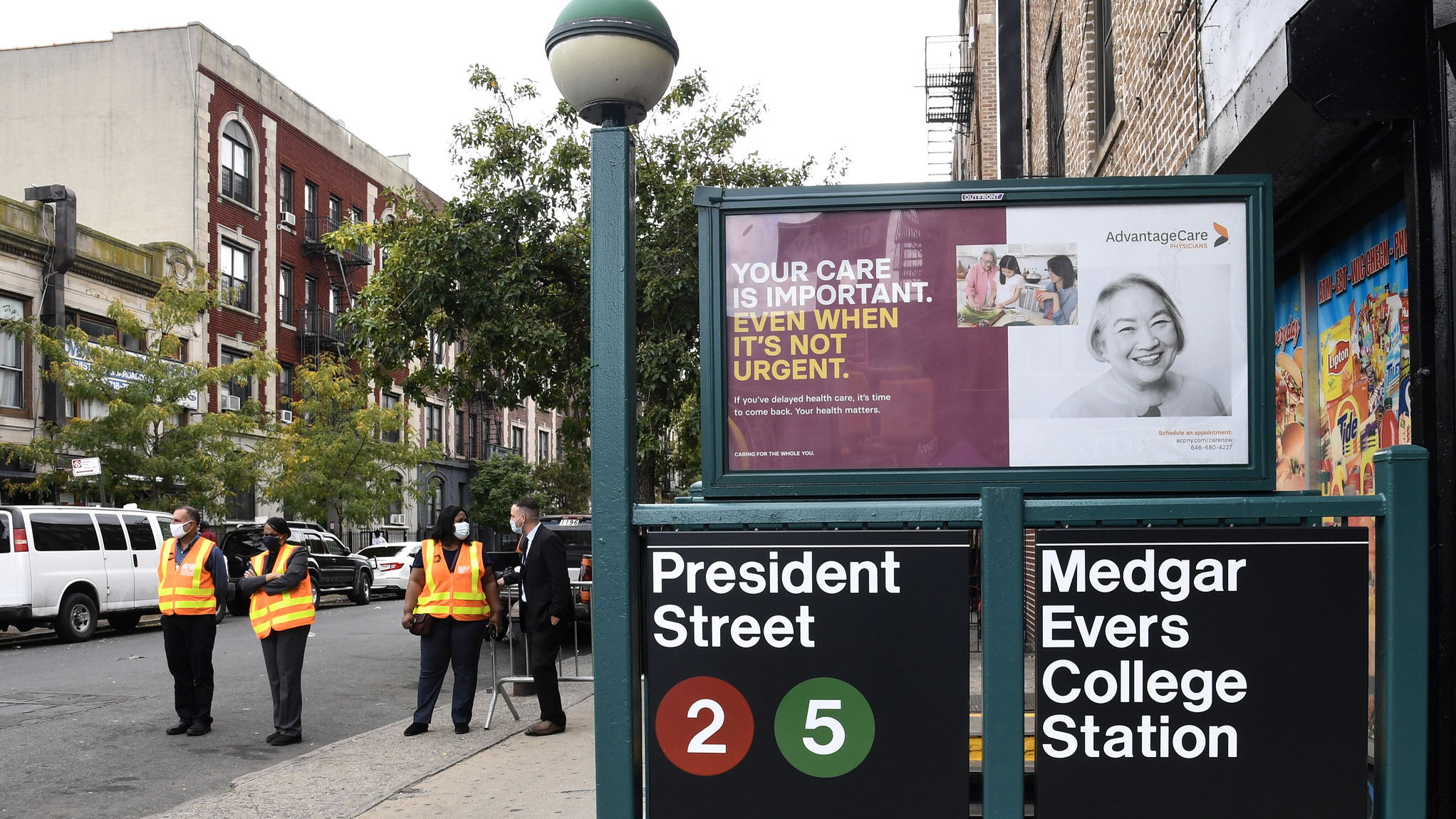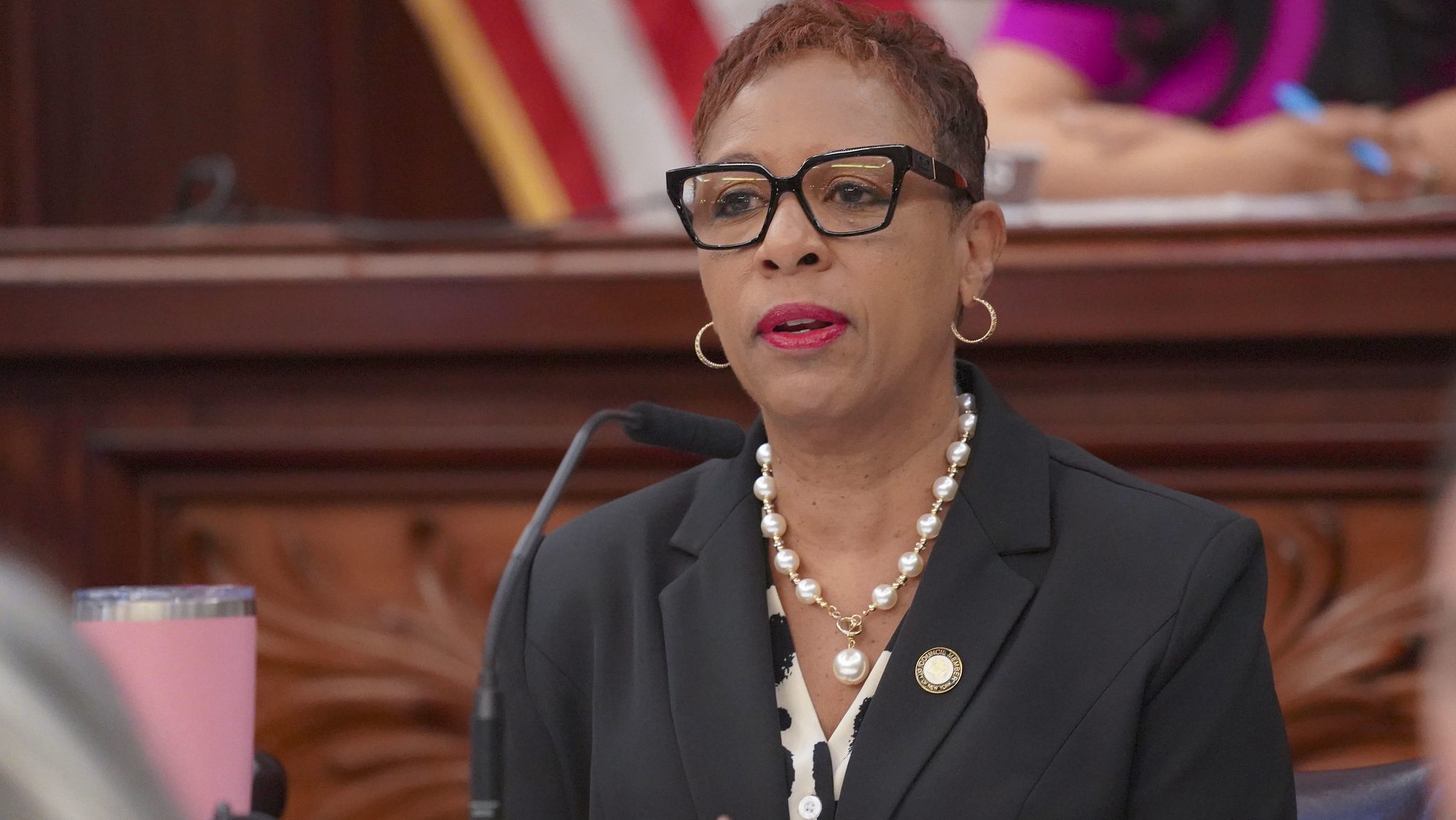The MTA will unclog a notoriously slow-rolling segment of the subway in Central Brooklyn to speed up service for riders of the 2, 3, 4 and 5 trains, according to the latest blueprint for the authority's 2025-2029 capital plan.
Nestled in an updated plan trsansit officials submitted to the MTA Board this week now that Gov. Hochul and state legislators funded, or claimed to have funded, the $68 billion plan, is a promise to untangle the bottleneck at Nostrand Junction, where trains must wait to criss-cross between local and express tracks east of the Franklin Avenue station complex.
The MTA has kicked around ideas for decades to unclog the bottleneck, which slows trains down between Franklin Avenue and the Nostrand Avenue stop on the 3 and President Street stop on the 2/5. Officials identified the bottleneck as a problem as far back as 1967. More recently, the agency put a revamp of the crossing in the 20-Year Needs Assessment it published in 2023. Now MTA leaders have thrown a version of that idea into their 2025-2029 capital plan.
"What we know as the 'Crown Heights Cluster' snarls thousands of commuters each day—and not just in Central Brooklyn, but across the system," said state Sen. Zellnor Myrie, who's pushed the MTA to take care of the issue. "Last year we stood with the Riders Alliance to demand a fix for the Nostrand bottleneck. I'm proud the MTA Capital Plan includes funding to finally un-cluster Crown Heights so more New Yorkers can get to work and school on time."

The project will rearrange the tracks so that trains that run express in Brooklyn west of Franklin Avenue can approach on the express tracks and trains that run local can stay on local tracks all the way through the junction.
The existing bottleneck occurs because of the service pattern of the four lines that run through Franklin Avenue: The 4 and 5 trains run express to the East Side of Manhattan west of Franklin, while the 2 and 3 run local to the West Side. East of Franklin, however, the pairs switch — the 4 and 3 run down east, while the 2 and 5 run south to Flatbush Avenue.
At Nostrand Avenue, a bi-level station, Brooklyn-bound 3 trains make local stops and Brooklyn-bound 4 express trains pass through on the way to Crown Heights-Utica Avenue. On the lower level, Manhattan-bound 3 trains stop and Manhattan-bound 4 trains pass through on an express track.
Just south of Nostrand Avenue station, 2 trains and 5 trains stop at President Street. Both lines run local service in Brooklyn between Franklin Avenue and Flatbush Avenue, but Manhattan-bound 5 trains run on the express track out of Franklin, while 2 trains run local service to Clark Street.
So, despite the fact that 5 train shares tracks with the 2 train between Flatbush Av-Brooklyn College and President Street, a Manhattan-bound 5 train needs to switch onto the express track as it enters Franklin Avenue.
Those complicated maneuvers come together as trains pull into Franklin, which is a single-level station where the Manhattan-bound and Brooklyn-bound local and express tracks surround separate platforms. In order for a Manhattan-bound 5 train to access the express track, it has to cross over the local track that the 2 train and 3 train use at Franklin Avenue. In the other direction, when a Flatbush Avenue-bound 5 train leaves Franklin Avenue, it has to get off the express track and onto the southbound local track.
The constant switching means a buildup of train traffic, and delays — as anyone who rides the four train lines can tell you about.
MTA officials' plan to untangle the bottleneck will reroute the trains so that the 2 train and 3 train go south to Flatbush Avenue, the 4 train makes express stops to Crown Heights-Utica Avenue and the 5 train goes express to New Lots Avenue, the current terminus of the 3 line. To replace the missing local service from the re-routed 3 train, the plan in the 20-Year Needs Assessment proposed an "8 train" to make local stops between Franklin and New Lots.
Transit planners are still determining how the trains are going to be labeled when all is said and done, and are still considering whether or not the 8 train will be part of the bottleneck project, MTA officials said. At the moment, the capital plan line item for the project says it "involves the installation of new crossover tracks and a modified routing plan for the trains that use Nostrand Junction."
But the general gist of the initial planning is focused on separating the local service from the express service, officials told Streetsblog. The Needs Assessment proposed building new crossover tracks between Utica Avenue and Kingston Avenue, and just to the north of Flatbush Ave-Brooklyn College station.
Making that switch will save over a minute of travel time for riders that rely on the 2, 3, 4 and 5 trains, and not just in Brooklyn. It will also cut down on delays that cascade through the system in Manhattan and the Bronx when trains are slowed down at Nostrand Junction, officials predict.
Untangling the current service pattern isn't the only thing that will speed up trains moving through Central Brooklyn, but the project will be a good start. The work in this capital plan won't include new signal upgrades for the junction, but the MTA planners did say that the work will get the area ready for modern signal upgrades.
The 4/5/6 Lexington Avenue line was originally slated for communications-based train control signals in the 2020-2024 capital plan, but post-pandemic and after the Second Avenue subway reduced crowding on the Lexington line, the MTA moved that project to a future plan.
CBTC signals for the 4/5 could wind up in the 2030-34 capital plan, and if the project extended to the Nostrand Junction area, it could be truly transformative for the train service through Brooklyn.
The combination of clearing up the junction and installing CBTC signals in the area could, according to old MTA studies on the problem, raise the number of trains moving through the junction from 44 trains per hour to 60 trains per hour.
Design work and other preliminary planning on the project is ongoing, and agency officials said that the actual physical construction is slated to start in the second half of the current capital plan.
"Brooklyn deserves more frequent and reliable service, and this capital plan will move dozens of projects closer to delivering it," said Jamie Torres-Springer, the president of MTA Construction & Development. "We're excited about this week’s vote and we're ready to deliver improvements to Nostrand Junction better, faster, and cheaper."






